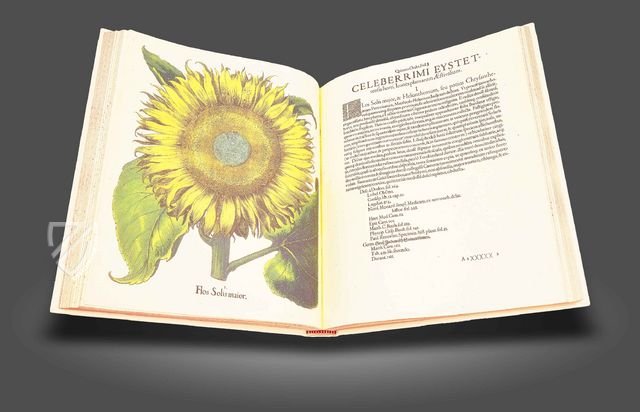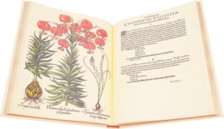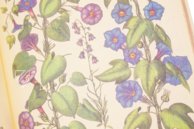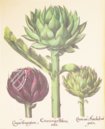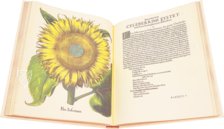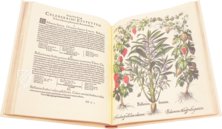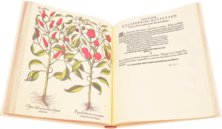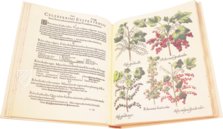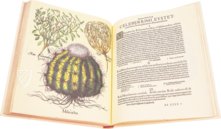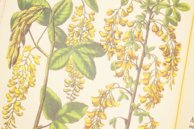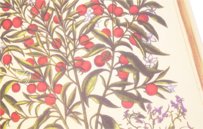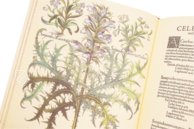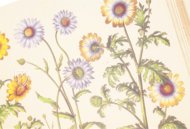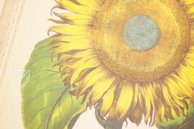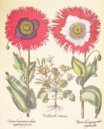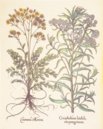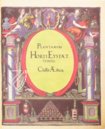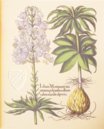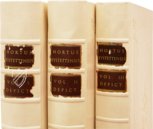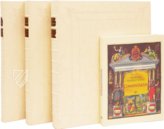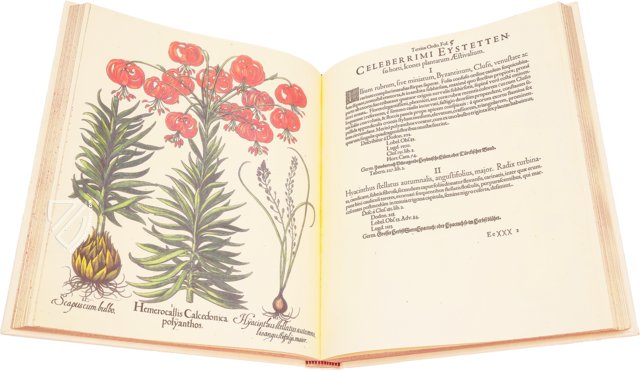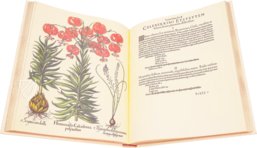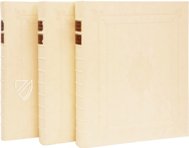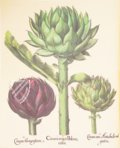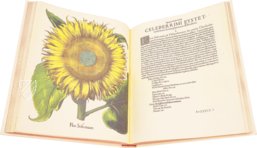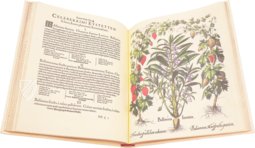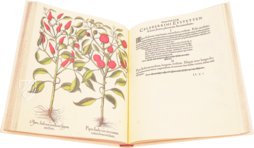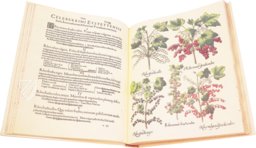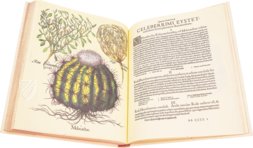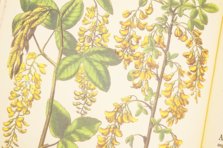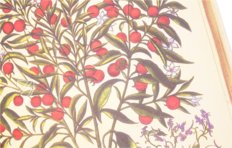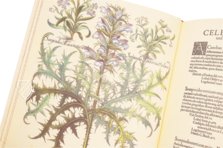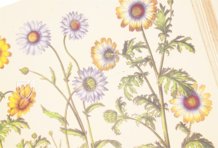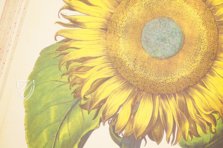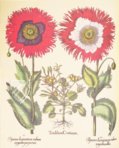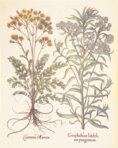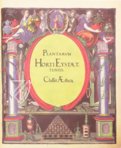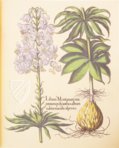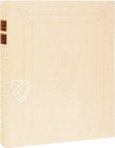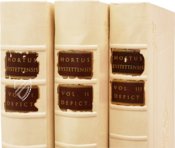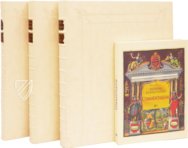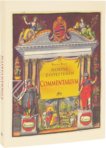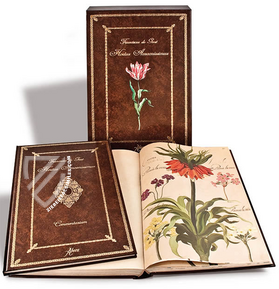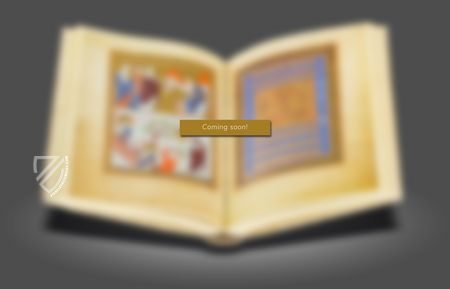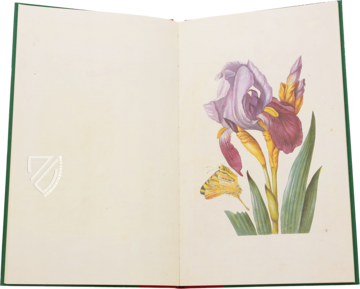Hortus Eystettensis
(7,000€ - 10,000€)
The title Hortus Eystettensis refers to the famous, comprehensive and gorgeously illustrated overview work on the flora of the episcopal botanical garden in Eichstätt. From 1595, the garden itself was laid out on behalf of the Prince-Bishop of Eichstätt, Johann Konrad von Gemmingen (1561–1612). The Nuremberg pharmacist Basilius Besler (1561–1629) was also involved in the conception and supervision of the green area on the bastions of Willibaldsburg castle. In 1613, he published an impressive work, the Hortus Eystettensis, which was intended to make the botanical garden known to a wide audience. In three large-format volumes, over 1,000 beautifully colored copperplate engravings present the native and exotic plants in impressive beauty and botanical accuracy. One of the rare and best-preserved first editions of this magnificent botanical work is kept in the Eichstätt University Library.
Hortus Eystettensis
Johann Konrad von Gemmingen (1561–1612), Prince-Bishop of Eichstätt, commissioned the installation of a botanical garden on the bastions of the Willibaldsburg castle above Eichstätt, the seat of the prince-bishops. The famous Hortus Eystettensis was laid out according to the conception and under the supervision of Joachim Camerarius and later Basilius Besler. Precious and exotic plants from both Europe as well as from other parts of the world were presented here in their magnificence and make the garden a means of representing the power of the Prince-Bishop of Eichstätt. The Hortus Eystettensis, which can still be admired today as it was originally conceived in the Willibaldsburg, was was one of the most famous gardens in Germany!
The Flora of the Hortus Eystettensis in a Luxury Volume
Basilius Besler (1561–1629), a pharmacist, botanist, and publisher from Nuremberg who was also responsible for the design of Eichstätt’s botanical garden, planned to make the Prince-Bishop’s Hortus Eystettensis available to the broader public through a publication. This splendid work finally appeared in the year 1613: three large-format volumes totaling 734 pages with 367 tables and 1,084 life-size representations of plants. Some of the tables can be unfolded upward so that one can see a plant on a single page from roots to flowers.
The Colored Depictions
Gorgeous and vividly, powerfully colored, these copperplate engravings present the great variety of the Hortus Eystettensis with its medical-, ornamental-, and agricultural-plants: splendidly blooming flowers and rare medicinal plants, delicious berries, and exotic fruits. The colored depictions possess both a beauty that flatters the eye as well as botanical accuracy. It was for that purpose that Besler obtained the support of the botanist Ludwig Jungermann.
The Precious First Edition
One of the few surviving first editions of the famous luxury botanical book Hortus Eystettensis can be found today in the Eichstätt University Library, where the original preliminary sketches for the grandiose copperplate engravings are also stored. This is “one of the best surviving copies of the colored first printing.” The luxury edition of the Hortus Eystettensis was a tremendous success and appeared into the 18th century in a total of five editions. The first edition – with colored copperplate etchings for good measure – is nevertheless considered to be the most magnificent!
Codicology
- Alternative Titles
- Eichstätter Garten
- Size / Format
- 3 volumes - 734 pages / 56.0 × 47.0 cm
- Origin
- Germany
- Date
- 1613
- Epochs
- Style
- Language
- Script
- Humanistic
- Illustrations
- 367 plates on "imperial" folios with 1084 life-size coloured copperplate engravings of plants in flower, 5 frontispieces and a plate with a portrait of the author
- Content
- Illustrated treatise on the plants of the Botanical Garden of the Willibaldsburg
- Patron
- Johann Konrad von Gemmingen, Prince Bishop of Eichstätt (1561–1612)
- Artist / School
- Basilius Besler (1561–1629)
Hortus Eystettensis
Artichoke
This very round, purple artichoke fruit is described by Basilius Besler as "Cinara Genuensium", which means "Genoese artichoke". The figure is limited to the visually appealing fruit and ignores all other parts of the plant such as the stem, leaves and blossoms. This clearly emphasizes the edible and therefore useful part for humans. Meanwhile, artfully placed light accents reflect the natural matt sheen on the fleshy bracts of the plant, which was originally cultivated in the Mediterranean region.
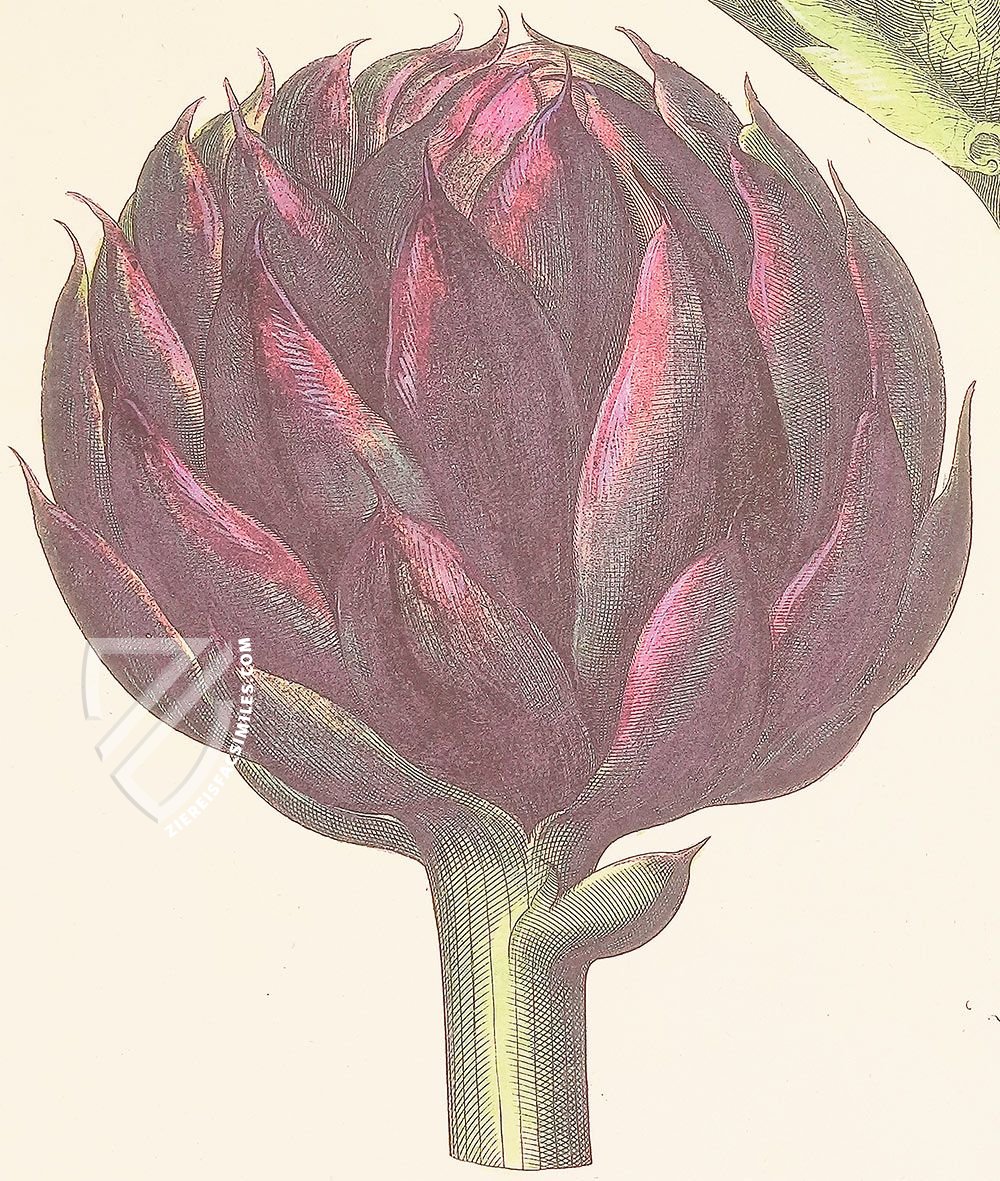
Hortus Eystettensis
Lilium Montanum
This page shows a species of lily that Basilius Besler entitled "Lilium Montanum". The two-parted depiction corresponds to the further description in the caption: dozens of white flowers with fine red speckles emerge from the long, straight stem. Another remarkable feature of the representation is the roots, which protrude as if the stem of the lily were in the soil.
The decorative plant could be a Lilium speciosum, which was originally endemic to Kyūshū and Shikoku in Japan before spreading as a popular plant for cultivation. Interestingly, its scaly bulb is edible when cooked and is said to be reminiscent of the taste of potatoes – it is therefore much more than just an ornamental plant!

#1 Hortus Eystettensis
Languages: English, German, Italian
(7,000€ - 10,000€)
- Treatises / Secular Books
- Apocalypses / Beatus
- Astronomy / Astrology
- Bestiaries
- Bibles / Gospels
- Chronicles / History / Law
- Geography / Maps
- Saints' Lives
- Islam / Oriental
- Judaism / Hebrew
- Single Leaf Collections
- Leonardo da Vinci
- Literature / Poetry
- Liturgical Manuscripts
- Medicine / Botany / Alchemy
- Music
- Mythology / Prophecies
- Psalters
- Other Religious Books
- Games / Hunting
- Private Devotion Books
- Other Genres
- Afghanistan
- Armenia
- Austria
- Belgium
- Colombia
- Croatia
- Cyprus
- Czech Republic
- Denmark
- Egypt
- Ethiopia
- France
- Germany
- Greece
- Hungary
- India
- Iran
- Iraq
- Israel
- Italy
- Japan
- Lebanon
- Luxembourg
- Mexico
- Morocco
- Netherlands
- Palestine
- Peru
- Poland
- Portugal
- Russia
- Serbia
- Spain
- Sri Lanka
- Sweden
- Switzerland
- Syria
- Turkey
- Ukraine
- United Kingdom
- United States
- Uzbekistan
- Aboca Museum
- Ajuntament de Valencia
- Akademie Verlag
- Akademische Druck- u. Verlagsanstalt (ADEVA)
- Aldo Ausilio Editore - Bottega d’Erasmo
- Alecto Historical Editions
- Alkuin Verlag
- Almqvist & Wiksell
- Amilcare Pizzi
- Andreas & Andreas Verlagsbuchhandlung
- Archa 90
- Archiv Verlag
- Archivi Edizioni
- Arnold Verlag
- ARS
- Ars Magna
- ArtCodex
- AyN Ediciones
- Azimuth Editions
- Badenia Verlag
- Bärenreiter-Verlag
- Belser Verlag
- Belser Verlag / WK Wertkontor
- Benziger Verlag
- Bernardinum Wydawnictwo
- BiblioGemma
- Biblioteca Apostolica Vaticana (Vaticanstadt, Vaticanstadt)
- Bibliotheca Palatina Faksimile Verlag
- Bibliotheca Rara
- Boydell & Brewer
- Bramante Edizioni
- Bredius Genootschap
- Brepols Publishers
- British Library
- C. Weckesser
- Caixa Catalunya
- Canesi
- CAPSA, Ars Scriptoria
- Caratzas Brothers, Publishers
- Carus Verlag
- Casamassima Libri
- Chavane Verlag
- Christian Brandstätter Verlag
- Circulo Cientifico
- Club Bibliófilo Versol
- Club du Livre
- CM Editores
- Collegium Graphicum
- Collezione Apocrifa Da Vinci
- Comissão Nacional para as Comemorações dos Descobrimentos Portugueses
- Coron Verlag
- Corvina
- CTHS
- D. S. Brewer
- Damon
- De Agostini/UTET
- De Nederlandsche Boekhandel
- De Schutter
- Deuschle & Stemmle
- Deutscher Verlag für Kunstwissenschaft
- DIAMM
- Droz
- E. Schreiber Graphische Kunstanstalten
- Ediciones Boreal
- Ediciones Grial
- Ediclube
- Edições Inapa
- Edilan
- Editalia
- Edition Deuschle
- Edition Georg Popp
- Edition Leipzig
- Edition Libri Illustri
- Editiones Reales Sitios S. L.
- Éditions de l'Oiseau Lyre
- Editions Medicina Rara
- Editorial Casariego
- Editorial Mintzoa
- Editrice Antenore
- Editrice Velar
- Edizioni Edison
- Egeria, S.L.
- Eikon Editores
- Electa
- Emery Walker Limited
- Enciclopèdia Catalana
- Eos-Verlag
- Ephesus Publishing
- Ernst Battenberg
- Eugrammia Press
- Extraordinary Editions
- Fackelverlag
- Facsimila Art & Edition
- Facsimile Editions Ltd.
- Facsimilia Art & Edition Ebert KG
- Faksimile Verlag
- Feuermann Verlag
- Folger Shakespeare Library
- Franco Cosimo Panini Editore
- Friedrich Wittig Verlag
- Fundación Hullera Vasco-Leonesa
- G. Braziller
- Gabriele Mazzotta Editore
- Gebr. Mann Verlag
- Gesellschaft für graphische Industrie
- Getty Research Institute
- Giovanni Domenico de Rossi
- Giunti Editore
- Graffiti
- Grafica European Center of Fine Arts
- Guido Pressler
- Guillermo Blazquez
- Gustav Kiepenheuer
- H. N. Abrams
- Harrassowitz
- Helikon
- Hendrickson Publishers
- Henning Oppermann
- Herder Verlag
- Hes & De Graaf Publishers
- Hoepli
- Holbein-Verlag
- Hortus Deliciarum
- Houghton Library
- Hugo Schmidt Verlag
- Idion Verlag
- Il Bulino, edizioni d'arte
- ILte
- Imago
- Insel Verlag
- Instituto Nacional de Antropología e Historia
- Istituto dell'Enciclopedia Italiana - Treccani
- Istituto Ellenico di Studi Bizantini e Postbizantini
- Istituto Geografico De Agostini
- Istituto Poligrafico e Zecca dello Stato
- Italarte Art Establishments
- J. Thorbecke
- Jan Thorbecke Verlag
- Johnson Reprint Corporation
- Josef Stocker
- Josef Stocker-Schmid
- Jugoslavija
- Karl W. Hiersemann
- Kasper Straube
- Kaydeda Ediciones
- Kindler Verlag / Coron Verlag
- Kodansha International Ltd.
- Konrad Kölbl Verlag
- Kurt Wolff Verlag
- La Liberia dello Stato
- La Linea Editrice
- La Meta Editore
- Lambert Schneider
- Landeskreditbank Baden-Württemberg
- Leo S. Olschki
- Les Incunables
- Library of Congress
- Libreria Musicale Italiana
- Lichtdruck
- Lito Immagine Editore
- Lumen Artis
- Lund Humphries
- M. Moleiro Editor
- Maison des Sciences de l'homme et de la société de Poitiers
- Manuscriptum
- Martinus Nijhoff
- Maruzen-Yushodo Co. Ltd.
- MASA
- McGraw-Hill
- Militos
- Millennium Liber
- Müller & Schindler
- Nahar and Steimatzky
- National Library of Wales
- Neri Pozza
- Nova Charta
- Oceanum Verlag
- Odeon
- Orbis Mediaevalis
- Orbis Pictus
- Österreichische Staatsdruckerei
- Oxford University Press
- Pageant Books
- Parzellers Buchverlag
- Patrimonio Ediciones
- Pattloch Verlag
- PIAF
- Pieper Verlag
- Plon-Nourrit et cie
- Prestel Verlag
- Princeton University Press
- Prisma Verlag
- Priuli & Verlucca, editori
- Pro Sport Verlag
- Propyläen Verlag
- Pytheas Books
- Quaternio Verlag Luzern
- Reales Sitios
- Recht-Verlag
- Reichert Verlag
- Reichsdruckerei
- Riehn & Reusch
- Roberto Vattori Editore
- Rosenkilde and Bagger
- Roxburghe Club
- Salerno Editrice
- Sarajevo Svjetlost
- Schöck ArtPrint Kft.
- Scolar Press
- Scrinium
- Scripta Maneant
- Scriptorium
- Siloé, arte y bibliofilia
- SISMEL - Edizioni del Galluzzo
- Sociedad Mexicana de Antropología
- Société des Bibliophiles & Iconophiles de Belgique
- Soncin Publishing
- Sorli Ediciones
- Stainer and Bell
- Studer
- Styria Verlag
- Sumptibus Pragopress
- Szegedi Tudomànyegyetem
- Taberna Libraria
- Tarshish Books
- Taschen
- Tempus Libri
- Testimonio Compañía Editorial
- Thames and Hudson
- The Clear Vue Publishing Partnership Limited
- The Facsimile Codex
- The Folio Society
- The Marquess of Normanby
- The Richard III and Yorkist History Trust
- Tip.Le.Co
- TouchArt
- TREC Publishing House
- TRI Publishing Co.
- Trident Editore
- Typis Regiae Officinae Polygraphicae
- Union Verlag Berlin
- Universidad de Granada
- University of California Press
- University of Chicago Press
- Urs Graf
- Vallecchi
- Van Wijnen
- VCH, Acta Humaniora
- VDI Verlag
- VEB Deutscher Verlag für Musik
- Verlag Anton Pustet / Andreas Verlag
- Verlag Bibliophile Drucke Josef Stocker
- Verlag der Münchner Drucke
- Verlag für Regionalgeschichte
- Verlag Styria
- Vicent Garcia Editores
- W. Turnowsky
- Waanders Printers
- Wiener Mechitharisten-Congregation (Wien, Österreich)
- Wissenschaftliche Buchgesellschaft
- Wydawnictwo Dolnoslaskie
- Xuntanza Editorial
- Zakład Narodowy
- Zollikofer AG

